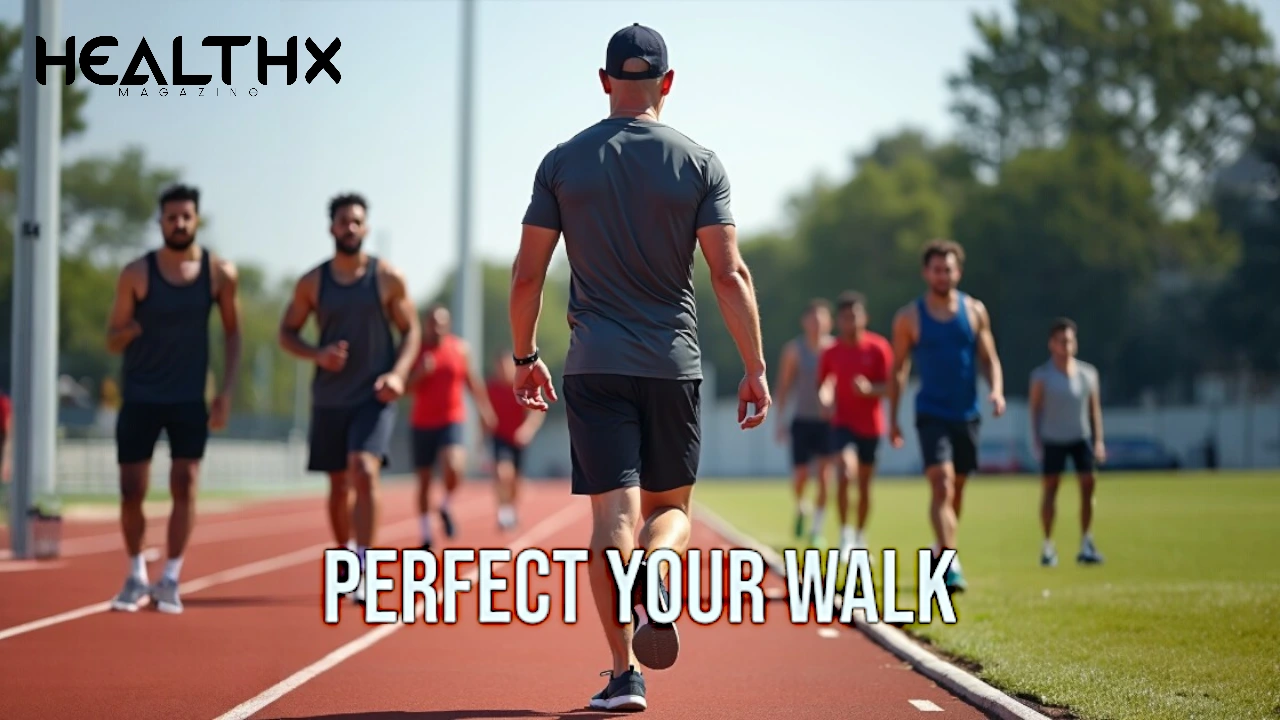Walking is one of the most fundamental forms of exercise, yet many of us overlook its importance and the impact it can have on our overall health. Improving your walking posture and choosing the right footwear can significantly enhance your walking experience, prevent injuries, and contribute to better physical health. In this comprehensive guide, we’ll explore expert advice on perfecting your walk through proper posture and footwear selection.
The Importance of Proper Walking Posture
Understanding Walking Posture
Walking posture refers to the alignment and positioning of your body while you walk. Proper posture ensures that your body is moving efficiently, reducing the risk of strain and injury.
Benefits of Correct Walking Posture
Improved Balance
Maintaining a correct walking posture helps improve your balance. This is especially important for older adults, as better balance reduces the risk of falls.
Reduced Risk of Injury
Proper posture minimizes the risk of injuries such as strains, sprains, and overuse injuries. It ensures that your muscles, ligaments, and joints are working harmoniously.
Enhanced Breathing
Walking with good posture allows for better lung expansion, improving your breathing efficiency. This can increase your stamina and endurance.
Boosted Confidence
Walking upright with a proper posture can enhance your confidence. It not only makes you look more poised but also improves your mood and energy levels.
Key Elements of Good Walking Posture
Head and Neck Position
Keep Your Head Up
Keep your head up and look straight ahead. Avoid looking down at your feet, which can cause neck strain and misalignment.
Align Your Neck
Your neck should be aligned with your spine. Imagine a string pulling your head upwards, lengthening your spine.
Shoulders and Arms
Relax Your Shoulders
Keep your shoulders relaxed and down. Avoid hunching or lifting them towards your ears.
Swing Your Arms Naturally
Allow your arms to swing naturally with each step. This helps maintain balance and aids in the momentum of your walk.
Core and Torso
Engage Your Core
Engage your core muscles to support your spine. This helps maintain a stable and upright posture.
Keep Your Torso Upright
Your torso should remain upright with a slight forward lean. Avoid slouching or leaning too far forward or backward.
Hips and Legs
Level Hips
Your hips should remain level and steady. Avoid excessive side-to-side movement, which can indicate imbalance.
Step Smoothly
Take smooth, even steps. Your foot should roll from heel to toe, providing a natural and efficient gait.
Feet and Ankles
Maintain Proper Foot Placement
Place your feet parallel to each other, pointing straight ahead. This alignment helps distribute your body weight evenly.
Flex Your Ankles
Flex your ankles with each step, allowing for a smooth transition from heel to toe. This reduces impact and enhances mobility.
Choosing the Right Footwear
Importance of Proper Footwear
Wearing the right footwear is crucial for maintaining good posture and preventing injuries. The wrong shoes can lead to discomfort, pain, and long-term health issues.
Characteristics of Good Walking Shoes
Adequate Arch Support
Arch support is essential for maintaining proper foot alignment and preventing overpronation or supination. Choose shoes that match your arch type.
Cushioning and Shock Absorption
Look for shoes with good cushioning and shock absorption. This helps reduce the impact on your joints, especially during long walks.
Proper Fit
Ensure your shoes have a proper fit. They should be snug but not tight, with enough room for your toes to move comfortably.
Breathability
Choose shoes made from breathable materials to keep your feet cool and dry. This helps prevent blisters and other foot issues.
Durability
Invest in durable shoes that can withstand regular use. High-quality materials and construction are essential for longevity.
Types of Walking Shoes
Stability Shoes
Stability shoes provide support and structure, making them ideal for people with flat feet or those who overpronate.
Motion Control Shoes
Motion control shoes offer maximum support and are suitable for individuals with severe overpronation.
Cushioned Shoes
Cushioned shoes are designed for those with high arches or those who need extra shock absorption.
Minimalist Shoes
Minimalist shoes promote a natural walking style with minimal cushioning and support. They are suitable for those who prefer a barefoot-like experience.
Tips for Perfecting Your Walk
Warm-Up and Stretch
Dynamic Warm-Up
Before you start walking, perform a dynamic warm-up to prepare your muscles and joints. This can include leg swings, hip circles, and arm swings.
Stretching Routine
Incorporate a stretching routine after your walk to improve flexibility and reduce muscle stiffness. Focus on your calves, hamstrings, and hip flexors.
Incorporate Interval Training
Speed Intervals
Add speed intervals to your walking routine to increase your heart rate and burn more calories. Alternate between brisk walking and a comfortable pace.
Incline Walking
Walk on an incline or uphill to challenge your muscles and improve cardiovascular fitness. This can be done on a treadmill or outdoor hills.
Track Your Progress
Use a Pedometer
A pedometer or fitness tracker can help you monitor your steps, distance, and calories burned. Tracking your progress keeps you motivated and helps you set goals.
Keep a Walking Journal
Maintain a walking journal to record your daily walks, including distance, time, and how you felt. This can help you identify patterns and make adjustments.
Listen to Your Body
Avoid Overtraining
Pay attention to your body’s signals and avoid overtraining. Rest when needed and gradually increase the intensity and duration of your walks.
Address Discomfort Early
If you experience discomfort or pain, address it early to prevent injuries. This may include adjusting your posture, changing shoes, or consulting a healthcare professional.
Common Walking Mistakes to Avoid
Overstriding
What is Overstriding?
Overstriding occurs when you take steps that are too long, causing your foot to land too far in front of your body. This can lead to joint strain and inefficiency.
How to Correct Overstriding
Focus on taking shorter, quicker steps. Your foot should land directly under your body to maintain proper alignment and reduce impact.
Slouching
Dangers of Slouching
Slouching can lead to poor posture, neck and back pain, and decreased lung capacity. It affects your overall walking efficiency.
How to Correct Slouching
Keep your shoulders relaxed and back, and engage your core muscles. Imagine a string pulling your head upwards to maintain an upright position.
Improper Footwear
Effects of Improper Footwear
Wearing improper footwear can cause blisters, foot pain, and long-term issues such as plantar fasciitis. It affects your gait and posture.
Choosing the Right Shoes
Invest in quality walking shoes that provide the necessary support, cushioning, and fit for your feet. Replace them regularly to ensure optimal performance.
Special Considerations
Walking for Weight Loss
Increasing Intensity
To lose weight through walking, increase the intensity by incorporating intervals, walking uphill, or adding resistance.
Consistency is Key
Consistency is crucial for weight loss. Aim for at least 30 minutes of brisk walking most days of the week.
Walking with Chronic Conditions
Consult a Professional
If you have a chronic condition such as arthritis or diabetes, consult with a healthcare professional before starting a walking program.
Adapt Your Routine
Adapt your walking routine to accommodate your condition. This may include shorter walks, using supportive devices, or walking at specific times of the day.
Conclusion
Perfecting your walk through proper posture and the right footwear can significantly enhance your walking experience and overall health. By following expert advice and incorporating these practices into your daily routine, you can walk more efficiently, reduce the risk of injury, and enjoy the many benefits that walking has to offer. Remember to listen to your body, make necessary adjustments, and stay consistent with your efforts. Happy walking!
FAQs
How often should I replace my walking shoes?
Replace
your walking shoes every 300-500 miles or when you notice significant wear and tear. This ensures you have adequate support and cushioning.
Can walking help with back pain?
Yes, walking with proper posture can help alleviate back pain by strengthening the muscles that support your spine and improving flexibility.
What is the best time of day to walk?
The best time to walk is when it fits into your schedule consistently. Morning walks can boost energy, while evening walks can help you unwind.
How can I make my walks more enjoyable?
Make walks more enjoyable by varying your routes, listening to music or podcasts, and walking with friends or family.
Is walking as effective as running for fitness?
Walking can be just as effective as running for improving fitness and losing weight, especially when done consistently and with the right intensity.












